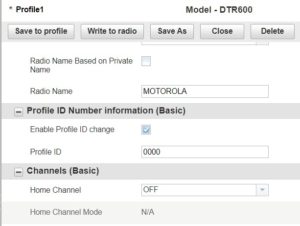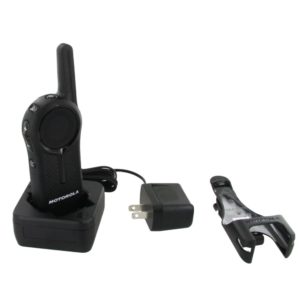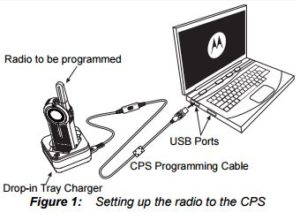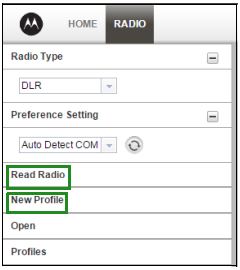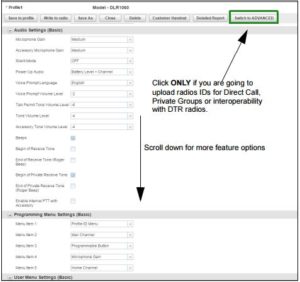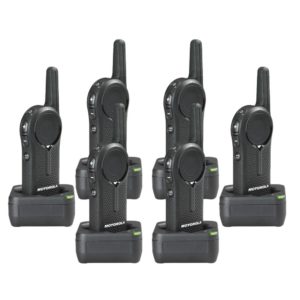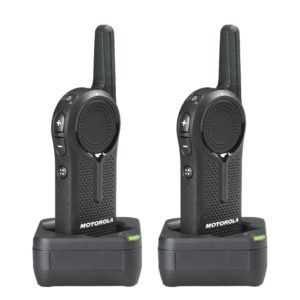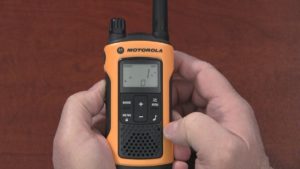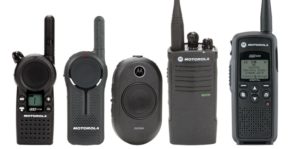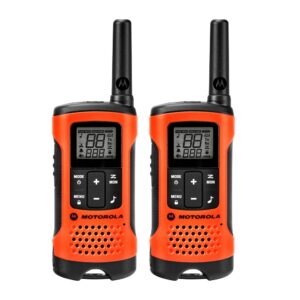 Some manufacturers of consumer FRS walkie talkies market their products based on the range in miles. We are often asked about the actual wattage of these radios, because these manufacturers don't usually include this information on their products. There is an obvious reason for this. It isn't impressive. In fact, if they did so, many consumers may be somewhat disappointed, because the wattage on these products is usually on the low end, often much lower than the maximum allowable wattage for FRS. In many cases, it doesn't even approach the >maximum allowed on the low power 467 MHz FRS frequencies, and that's when the radio is operating at high power!
Some manufacturers of consumer FRS walkie talkies market their products based on the range in miles. We are often asked about the actual wattage of these radios, because these manufacturers don't usually include this information on their products. There is an obvious reason for this. It isn't impressive. In fact, if they did so, many consumers may be somewhat disappointed, because the wattage on these products is usually on the low end, often much lower than the maximum allowable wattage for FRS. In many cases, it doesn't even approach the >maximum allowed on the low power 467 MHz FRS frequencies, and that's when the radio is operating at high power!
It's even more ironic when you consider that, until the Part 95 Reform of 2017, Most of these were FRS and GMRS hybrid radios that were often assumed to operate at the maximum wattage allowed on GMRS handhelds. The maximum allowable power on GMRS channels at the time was 5 watts. The power output for the GMRS, and hence the overall range, was actually very weak on nearly all of these models, which is why many licensed GMRS users preferred business radios over the consumer models.
The Great Reform changed all that. In 2017 the FCC separated the FRS/GMRS hybrids, allowing the channels previously reserved for GMRS to be shared with FRS as well, and while the seven 467 MHz FRS channels remained at one-half watt (0.5W) max, it raised the maximum allowable wattage on the now fifteen 462 MHz FRS channels to 2 watts.
This was welcome news to almost all users, since it encouraged manufacturers to make dedicated GMRS radios with higher wattage, and gave FRS users more power and greater range. In essence, what the reform did was re-classify hybrid "bubble pack" radios that were under 2 watts as license-free FRS radios. With the exception of a couple of Midland handheld radios that were above 2 watts, nearly all of the hybrid radios were well under that 2 watt limit, and therefore became FRS radios.
So, the manufacturers could now sell all of these hybrid radios, which previously required a license to operate on the GMRS channels, as FRS only radios that were "license-free". One would think that this would provide more opportunity and innovation with the introduction of 2 watt FRS radios, since that became the new limit. But that's not what happened, at least, not right away. With the exception of Wouxun, which jumped right on this one with the full 2 watt KG-805F FRS radio, a majority of the manufacturers chose to stick with their current lineup and simply re-label them all as FRS.
One of these manufacturers was Motorola. Although they did apply wattage changes to a few models, for the most part it was business as usual. Their Talkabout line is a prime example of how low the power can go on the high power setting. And Motorola is not the only one. Other bubble pack manufacturers did the same.
Many consumers mistakenly assume that because it is an FRS radio advertised at 35 miles range or more, it operates at the full 2 watts. But that's not quite accurate. And this is why we receive queries and complaints that their Motorola, Cobra or Uniden radios can't make it a couple of miles, or sometimes even a couple of city blocks. It's because these radios are not a full 2 watts, and some are only capable of operating at a fraction of what the FCC allows. A few are not much more powerful than the little walkie talkies sold as toys.
Yet, you'll often find them in use in some mom and pop retail stores, restaurants, schools and churches.
Just how powerful aren't they? The chart below lists some popular Motorola Talkabout radios, their advertised range and their actual wattage, according to the official documentation on file at the FCC.
It is important to note that a few of the radios listed in the following chart have "inverted" wattages, meaning that 467 MHz channels may actually have higher wattage than the 462 MHz channels! Strange, indeed.
| Motorola Talkabout Wattage Comparison | |||||
|---|---|---|---|---|---|
| Model | FCC ID | Range* | Adjustable Power | Low Wattage | Max Wattage |
 T100 | AZ489FT4930 | 16 Miles | 0.19W | 0.2W** | |
 T107 | AZ489FT4930 | 16 Miles | 0.19W | 0.2W** | |
 T200 | AZ489FT4928 | 20 Miles | 0.411W | 0.47W** | |
 T260 | AZ489FT4929 | 25 Miles | 0.4W | 0.8W | |
 T265 | AZ489FT4929 | 25 Miles | 0.4W | 0.8W | |
 T280 | AZ489FT4929 | 25 Miles | 0.4W | 0.8W | |
 T400 | AZ489FT4924 | 35 Miles | 0.48W | 1.71W | |
 T402 | AZ489FT4924 | 35 Miles | 0.48W | 1.71W | |
 T460 | AZ489FT4924 | 35 Miles | 0.48W | 1.71W | |
 T465 | AZ489FT4924 | 35 Miles | 0.48W | 1.71W | |
 T480 | AZ489FT4925 | 35 Miles | 0.37W | 1.39W | |
 T600 | AZ489FT4927 | 35 Miles | ✔ | 0.4W | 1.3W |
 T605 | AZ489FT4927 | 35 Miles | ✔ | 0.4W | 1.3W |
 T800 | AZ489FT4947 | 35 Miles | ✔ | 0.4W | 0.75W |
*Motorola advertises FRS/GMRS radio range in miles, however your actual range may vary as it depends on a number of variables. For more information watch our short video Radio 101 - The Truth About FRS/GMRS Two Way Radio Range.
**The "low power" 467 MHz channels have the higher wattage.











